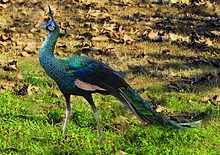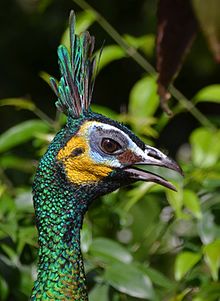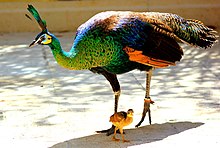European green peacock
| European green peacock | ||||||||
|---|---|---|---|---|---|---|---|---|

Wheel of the male green peacock |
||||||||
| Systematics | ||||||||
|
||||||||
| Scientific name | ||||||||
| Pavo muticus | ||||||||
| Linnaeus , 1766 |
The green peacock ( Pavo muticus ), also known as the green peacock , is a species of bird from the pheasant-like family and is a close relative of the blue peacock ( Pavo cristatus ) and can be crossed with it (a Spalding peacock is created ). The green peacock occurs naturally only in Southeast Asia . Three subspecies are described, which differ in the color of the wings and the green shade of the body plumage.
Today the green peacock is only found in small parts of its range. The stock is declining strongly, the stock situation is therefore indicated with "en" (= endangered - strongly endangered). The reasons for the decline in the population are varied: The green peacock is hunted for both its meat and its feathers. In Thailand and China it is classified as an agricultural pest and sometimes poisoned in a targeted manner. The increasing urban sprawl in its area of distribution increases the hunting pressure on it, fragments its habitats and isolates the individual populations from one another.
features
Males reach a body weight of 3.8 to 5 kilograms, females weigh between 2.7 and 4 kilograms, with the Burmese peacock being the largest subspecies. The green peacock varies greatly in color depending on the subspecies, but the breast and neck are always green or green-gray. The green peacock is longer-legged than the blue peacock, has a longer and slimmer neck and a more upright posture. Therefore, despite its lower weight, it appears larger than this.
Males of the nominate form
The males of the nominate form have short, metallic, shiny blue-green feathers on the vertex, throat and a narrow section on the upper neck. On the back center of the head there is an almost vertical tuft of narrow golden-green feathers that are about 12 to 15 centimeters long. The head sides are partly feathered, the feathered parts are partly light cobalt blue, partly light chrome yellow. The featherless sides of the head are divided in two by a short-feathered blue-black rein band.
The feathers on the neck, on the upper back and on the chest form a scale pattern with their wide coppery gold and narrow green fringing. The back plumage is metallic light green, a scale pattern is created by the narrow black border. The 100 to 150 upper tail cover feathers form a long train that can reach a length between 140 and 160 centimeters. The long upper tail feathers are supported by 20 control feathers. The individual feathers have an ocher-brown shaft region and are hemmed at the end. The coverts have a large round to heart-shaped eye spot (so-called "peacock eye") before the end. This eye spot consists of a dark blue central spot, which is surrounded by a wide, bright enamel blue and a bronze brown as well as a narrow gold-green and a narrow bronze-colored ring.
The elytra are bright metallic green and blue-green. The arm covers are black-brown with isabel-colored speckles and a blue-green fringing of the feathers. The hidden inside flags of the arm wings are black-brown, the outside flags are dark blue and green. The silences, on the other hand, are solid dark brown. Flanks and belly are dark green, the thighs are black with a brown speckle.
Females, juveniles and subadult males
Females are very similar to males in terms of their overall coloration, but overall they are somewhat more dull. The most noticeable difference to the males is the lack of a long train. On the face, the rein stripe is maroon instead of blue-black as in the males. The breast plumage is mottled isabel-colored in the females. The back and the inner wing covers are black, banded in ocher and lined with green. The upper tail-coverts are not the length of the males, but almost reach the end of the tail feathers. They are banded gold-green and isabel-colored and have black speckles. The tail feathers are black with ocher banding. The wings of the hand are ocher-colored and have black spots on the outside flags and parts of the feathers.
Young birds of both sexes are similar to the females, but are much more dull and have individual white feathers, especially on the face and in the throat area.
Annual males are similar to females, but differ from them by their long legs, the blue-black rein stripes and the wings of the hand, which are almost pure ocher in color. Two-year-old males already resemble the adult males, but their train is much shorter and they still lack eye spots. The train only reached its maximum length in five-year-old males.
voice
The males' call for territory is a widely audible kii-ou . This can be heard above all in the early morning and late afternoon. If they are startled, then they flee either without shouting or with soft tak tak tak-krooo yells . In the event of a massive disruption that causes them to be exposed, they sound alarm calls that can be heard from afar. Grazing hoofed game also reacts to these alarm calls, with which the green peafowl respond to tiger roaring.
distribution and habitat
The historical distribution area of the green peacock stretched from northeast India and Bangladesh through Myanmar and southern China to Vietnam and Malaysia to the island of Java. It was once thought to be the easiest species of the pheasant family to observe in Asia. Today the green peacock can only be found in a few small and isolated areas.
The green peacock was already extinct on the Malay Peninsula in the mid-1960s. At that time it had already disappeared in large parts of its Chinese distribution area and the same was true for northeast India and possibly also for Bangladesh. In Thailand there is a single large population in the Huai Kha Khaeng Wildlife Sanctuary that may even be increasing. In Vietnam, the population is also falling sharply, but the green peacock still occurs in the Cát Tiên National Park and in the Yok Đôn National Park . There are several small and isolated populations in Yunnan, China. The green peacock occurs in several places on Java, most of them in the Ujung Kulon National Park and the Baluran Nature Park . There are also individual occurrences in Myanmar and Cambodia.
Subspecies and their respective distribution area
There are three subspecies of the eared peacock, named after the areas in which they are found.
- Pavo muticus muticus Linnaeus , 1766
- Burmese green peafowl, or Arrakan green peacock (northeast India and northwest Burma , possibly extinct)
- Pavo muticus spicifer Shaw , 1804
- Pavo muticus imperator Delacour , 1949
habitat
The habitat of the green peacock are light forests, forest edges and forest meadows. In Java they are also found on teak plantations. In Laos, their typical habitat is sparse mixed forests and stony grass steppes in the vicinity of evergreen patches of forest.
Reproduction
Green peafowl are polygamous ; a single male has a harem consisting of up to five females.
The nest is a shallow hollow in the ground and is built in the wild in such places that offer some protection but at the same time offer the breeding female the opportunity to observe the surroundings. The female breeds alone. The breeding season lasts 26 to 28 days. The chicks are led by the mother for over three months.
attitude
In China and Japan the peacock was kept as an ornamental bird. According to Raethel, he is the peacock that is represented in traditional art in both countries and the descriptions of the species by Buffon , Brisson and Linné in the 18th century are based on a picture that a Japanese emperor gave to the pope.
As far as we know, the eared peacock was not kept in Europe before the 19th century, the first keeping in the zoological garden of London is documented for 1831. Edward Smith-Stanley, 13th Earl of Derby , also kept this species of peacock in his menagerie at Knowsley Hall from 1851 . The first European breeding was probably also achieved in 1867 by the London Zoo.
Unlike the blue peacock, the green peacock is sensitive to cold, not true to its location and more aggressive than this. Therefore it is only suitable for free range keeping to a very limited extent. The male peacocks only call during courtship time in spring and much less often, and their voice is deeper and quieter than that of their relative.
literature
- Steve Madge , Philip McGowan and Guy M. Kirwan : Pheasants, Partridges and Grouse. A Guide to the Pheasants, Partridges, Quails, Grouse, Guineafowl, Buttonquails and Sandgrouse of the world. Christopher Helm, London 2002, ISBN 0-7136-3966-0 .
- Heinz-Sigurd Raethel : Chicken birds of the world. Natur Verlag, Weltbild Verlag, Augsburg 1991, ISBN 3-89440-440-X .
Web links
- http://www.wpadeutschland.de/Seiten/Tierseiten/imperator-pfau.html
- http://www.wpadeutschland.de/Seiten/Tierseiten/muticus-pfau.html
- http://www.gbwf.org/pheasants/green_peafowl.html
- http://www.world-of-animals.de/tierlexikon/tierart_Pfau.html
- ITIS - Pavo muticus
- Pavo muticus in the endangered Red List species the IUCN 2008. Posted by: BirdLife International, 2008. Accessed on December 19 of 2008.
- Videos, photos and sound recordings of Pavo muticus in the Internet Bird Collection
Individual evidence
- ↑ a b c d e f g h Madge, McGowan and Kirwan: Pheasants, Partridges and Grouse . P. 343.
- ↑ a b Pavo muticus in the endangered Red List species the IUCN 2008. Posted by: BirdLife International, 2008. Accessed August 28, 2016th
- ↑ a b Madge, McGowan and Kirwan: Pheasants, Partridges and Grouse . P. 342.
- ↑ Raethel: Chicken Birds of the World . P. 711
- ↑ Raethel: Chicken Birds of the World . P. 712.
- ↑ Raethel: Chicken Birds of the World . P. 109
- ↑ Raethel: Chicken Birds of the World . P. 710.






